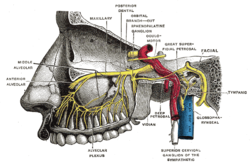| Tympanic nerve | |
|---|---|
 Plan of upper portions of glossopharyngeal, vagus, and accessory nerves. (Tympanic nerve visible in upper right) Plan of upper portions of glossopharyngeal, vagus, and accessory nerves. (Tympanic nerve visible in upper right) | |
 Tympanic nerve (labelled right side) Tympanic nerve (labelled right side) | |
| Details | |
| To | Tympanic plexus |
| Identifiers | |
| Latin | nervus tympanicus |
| TA98 | A14.2.01.138 |
| TA2 | 6323 |
| FMA | 53480 |
| Anatomical terms of neuroanatomy[edit on Wikidata] | |
The tympanic nerve (Jacobson's nerve) is a branch of the glossopharyngeal nerve passing through the petrous part of the temporal bone to reach the middle ear. It provides sensory innervation for the middle ear, the Eustachian tube, the parotid gland, and mastoid cells. It also carries parasympathetic fibers destined for the parotid gland.
Structure
The tympanic nerve contains sensory axons to the middle ear (including the internal surface of the tympanic membrane) whose cell bodies are lodged in the superior ganglion of the glossopharyngeal nerve.
It also contains parasympathetic axons which continue as the lesser petrosal nerve to the otic ganglion, which itself gives off postganglionic parasympathetic neurons.
Origin
The tympanic nerve arises from the inferior ganglion of the glossopharyngeal nerve (CN IX) in the jugular fossa.
Course
It passes through the petrous part of the temporal bone within the tympanic canaliculus that is situated within the bony ridge separating the carotid canal and the jugular foramen to reach the middle ear.
In the tympanic cavity of the middle ear, it ramifies upon the promontory of tympanic cavity to form the tympanic plexus.
Distribution
Sensory
The tympanic nerve provides sensation to the middle ear (tympanic cavity). This includes the internal surface of the tympanic membrane. It also supplies the Eustachian tube, the parotid gland, and mastoid air cells.
Parasympathetic autonomic
The tympanic nerve is also the parasympathetic root of the otic ganglion. These neurons then provide secretomotor innervation of the parotid gland via the auriculotemporal nerve. It is involved in the salivatory reflex to increase salivation during chewing.
Variation
The tympanic nerve usually arises from the inferior ganglion of the glossopharyngeal nerve. Rarely, it may arise from a higher part. Rarely, it may provide no parasympathetic fibres to the otic ganglion.
Clinical significance
The tympanic nerve is involved in a reflex, where stimulation of the ear canal increases salivation.
Cancer
The tympanic nerve may be involved by paraganglioma, in this location referred to as a glomus tympanicum tumour. This causes a soft mass in the middle ear (tympanic cavity). There may also be pulsatile tinnitus, hearing loss or hearing problems, and some cardiac abnormalities.
History
The tympanic nerve is also known as the nerve of Jacobson, or Jacobson's nerve.
Additional images
-
 Lesser petrosal nerve
Lesser petrosal nerve
-
 Sympathetic connections of the otic and superior cervical ganglia.
Sympathetic connections of the otic and superior cervical ganglia.
References
![]() This article incorporates text in the public domain from page 910 of the 20th edition of Gray's Anatomy (1918)
This article incorporates text in the public domain from page 910 of the 20th edition of Gray's Anatomy (1918)
- ^ Tubbs, R. Shane; Shoja, Mohammadali; Loukas, Marios (2015). "26 - Anatomy of the Glossopharyngeal Nerve". Nerves and Nerve Injuries. Vol. 1: History, Embryology, Anatomy, Imaging, and Diagnostics. Academic Press. pp. 371–383. doi:10.1016/B978-0-12-410390-0.00027-5. ISBN 978-0-12-410390-0.
- ^ Sinnatamby, Chummy S. (2011). Last's Anatomy (12th ed.). p. 366. ISBN 978-0-7295-3752-0.
- ^ Thomas, P. K.; Mathias, Christopher J. (2005). "52 - Diseases of the Ninth, Tenth, Eleventh, and Twelfth Cranial Nerves". Peripheral Neuropathy. Vol. 2 (4th ed.). Saunders. pp. 1273–1293. doi:10.1016/B978-0-7216-9491-7.50055-7. ISBN 978-0-7216-9491-7.
- ^ Barral, Jean-Pierre; Croibier, Alain (2009). "21 - Glossopharyngeal nerve". Manual Therapy for the Cranial Nerves. Churchill Livingstone. pp. 181–189. doi:10.1016/B978-0-7020-3100-7.50024-0. ISBN 978-0-7020-3100-7.
- ^ Weissleder, Ralph; Wittenberg, Jack; Harisinghani, Mukesh G.; Chen, John W. (2011). "7 - Head and Neck Imaging". Primer of Diagnostic Imaging (5th ed.). Mosby. pp. 427–461. doi:10.1016/B978-0-323-06538-2.00007-X. ISBN 978-0-323-06538-2.
External links
- Tympanic and Lesser petrosal nerve diagram
- cranialnerves at The Anatomy Lesson by Wesley Norman (Georgetown University) (IX)
| The cranial nerves | |||||||||||||
|---|---|---|---|---|---|---|---|---|---|---|---|---|---|
| Terminal (CN 0) |
| ||||||||||||
| Olfactory (CN I) |
| ||||||||||||
| Optic (CN II) |
| ||||||||||||
| Oculomotor (CN III) |
| ||||||||||||
| Trochlear (CN IV) |
| ||||||||||||
| Trigeminal (CN V) |
| ||||||||||||
| Abducens (CN VI) |
| ||||||||||||
| Facial (CN VII) |
| ||||||||||||
| Vestibulocochlear (CN VIII) | |||||||||||||
| Glossopharyngeal (CN IX) |
| ||||||||||||
| Vagus (CN X) |
| ||||||||||||
| Accessory (CN XI) | |||||||||||||
| Hypoglossal (CN XII) | |||||||||||||